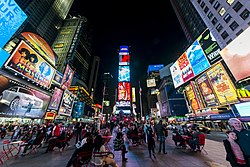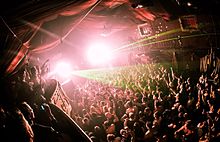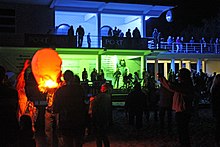Nightlife



Nightlifeis a collective term forentertainmentthat is available and generally more popular from the late evening into the early hours of the morning.[2]It includespubs,bars,nightclubs,parties,livemusic,concerts,cabarets,theatre,cinemas,and shows. These venues often require acover chargefor admission. Nightlife entertainment is often moreadult-oriented than daytime entertainment. People who prefer to be active during the night-time are callednight owls.[3]
History
[edit]The lack ofelectric lighting,as well as the needs foragricultural labor,made staying up after dark difficult for most people. Larger ancient cities, such asRome,had a reputation for danger at night.[4]This changed in 17th and 18th-centuryEurope(and subsequently spread beyond) due to the development and implementation of artificial lighting: more domestic lights, added street lighting, and adaptation by the royal and upper social classes.[5]The introduction of chocolate, coffee and tea, and cafes that stayed open through dawn, became part of the new culture.[5]
Sociological research
[edit]
Nightlife has been a vibrant area of research forsociologists.Nightlife establishments including pubs, bars, and nightclubs function asthird places,according toRay OldenburginThe Great Good Place.[6]
Some sociologists have argued that vibrant city nightlife scenes contribute to the development of culture as well as political movements. David Grazian cites as examples the development ofbeat poetry,musical styles includingbebop,urban bluesand early rock, and the importance of nightlife for the development of thegay rights movementin the United States kicked off by theriots at the Stonewall Inn nightclubinGreenwich Village,Lower Manhattan,New York City.[7]
There is debate about the degree to which nightlife contributes positively tosocial capitaland the public goods of society. David Grazian points out that nightlife can "replicate the same structures of race, ethnic, and class inequality and exclusion found in the larger society."[7]
Grazian cites the use of dress codes by some nightlife establishments in the United States—mostly nightclubs—that specifically targets clothing popularized by hip hop culture represents a form of informal discrimination and segregation on racial grounds.[7]He also noted that nightclubs and club culture can create an environment that encourage or tolerate the "harassment and degradation of women," citing the expectation that both female workers and patrons of bars and nightclubs engage in highly sexualized performances of femininity including dressing in a particularly sexual manner in order to gain entrance to clubs.[7]
Modernity impact
[edit]The supervisioned use of lighting in contrast to daylight, is correlated with human control over the use oftechnology.[8]Research conducted byEuromonitor Internationalindicates a growing demand for unique, immersive nightlife experiences among millennials and Generation Zero.[9]Moreover, advancements indigital platformsandsocial mediahave reshaped how people discover and engage with nightlife, amplifying its influence and reach.[10]As cities continue to embrace innovation and diversity, the nightlife procure remains a dynamic expression of modernity's ever-evolving spirit.[11]The evolve inurban landscapereflects in the nightlife customs through the zeitgeists of contemporary society.[12]
Regulation
[edit]
Australia
[edit]Nightlife venues must be licensed to serve alcohol.
United Kingdom
[edit]Nightlife venues must be licensed to serve alcohol under theLicensing Act 2003(and the Licensing (Scotland) Act 2005 inScotland). Venues with door security ( "bouncers" ) are also required to ensure that the security staff are licensed by theSecurity Industry Authority.[13]
Since the introduction of theLicensing Act 2003,pubs and bars have been able to apply to operate until later. For nightclubs, this has become a form of competition as patrons can stay in the same pub or bar rather than move on to a club.[14]
United States
[edit]In theUnited States,legislation affecting nightlifeis handled primarily at state and local levels.
References
[edit]- ^Flannigan, Jenna; Miscone, Michael (January 18, 2011)."A history of NYC nicknames".Time Out New York.Archivedfrom the original on September 5, 2017.RetrievedAugust 20,2022.
- ^"Nightlife - Definition of nightlife by Merriam-Webster".merriam-webster.com.Archivedfrom the original on June 18, 2015.RetrievedJune 18,2015.
- ^Klein, Stefan (2008).Time.p. 20.
- ^Linn, Jason (2014).The dark side of Rome: a social history of nighttime in ancient Rome.Santa Barbara, California: University of California.ISBN9781321349702.RetrievedDecember 23,2022.
- ^abBenjamin Schwarz (April 2012). "Night Owls".Atlantic Magazine.pp. 82–83.
- ^"Ray Oldenburg".Project for Public Spaces.Archivedfrom the original on July 2, 2015.RetrievedJune 18,2015.
- ^abcdGrazian, David (2009). "Urban Nightlife, Social Capital, and the Public Life of Cities".Sociological Forum.24(4): 908–917.doi:10.1111/j.1573-7861.2009.01143.x.JSTOR40542603.
- ^Smith, John (2020). "Nightlife in Modern Cities".Journal of Urban Culture.15(2): 78–94.
- ^"Global Nightlife Tourism: Trends Shaping the Industry".London: Euromonitor International. 2021.
- ^Li, Wei; Wang, Hao (2019). "The Impact of Social Media on Nightlife Experience Creation".International Journal of Contemporary Hospitality Management.17(2): 89–104.
- ^Rachel, Gibson (2020).The Evolution of Urban Nightlife.New York: Routledge.
- ^Lee, Sungho (2020). "Evolving Urban Spaces and the Nightlife Scene".Journal of Urban Development.42(1): 45–60.
- ^"Licensing Act 2003".legislation.gov.uk.Archivedfrom the original on July 2, 2016.RetrievedJune 17,2015.
- ^Moss, Stuart (2010).The Entertainment Industry: An Introduction.CABI. p. 66.ISBN978-1-84593-551-1.Archivedfrom the original on January 8, 2016.RetrievedNovember 14,2015.
